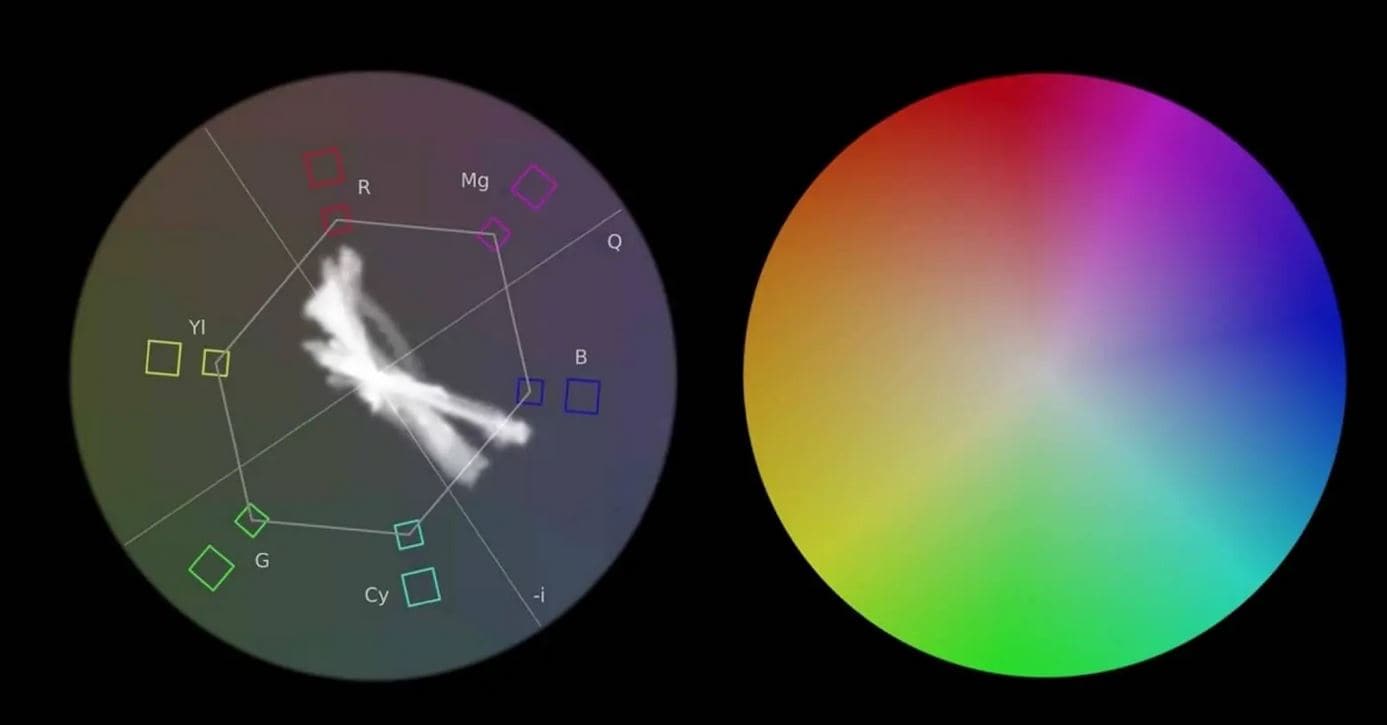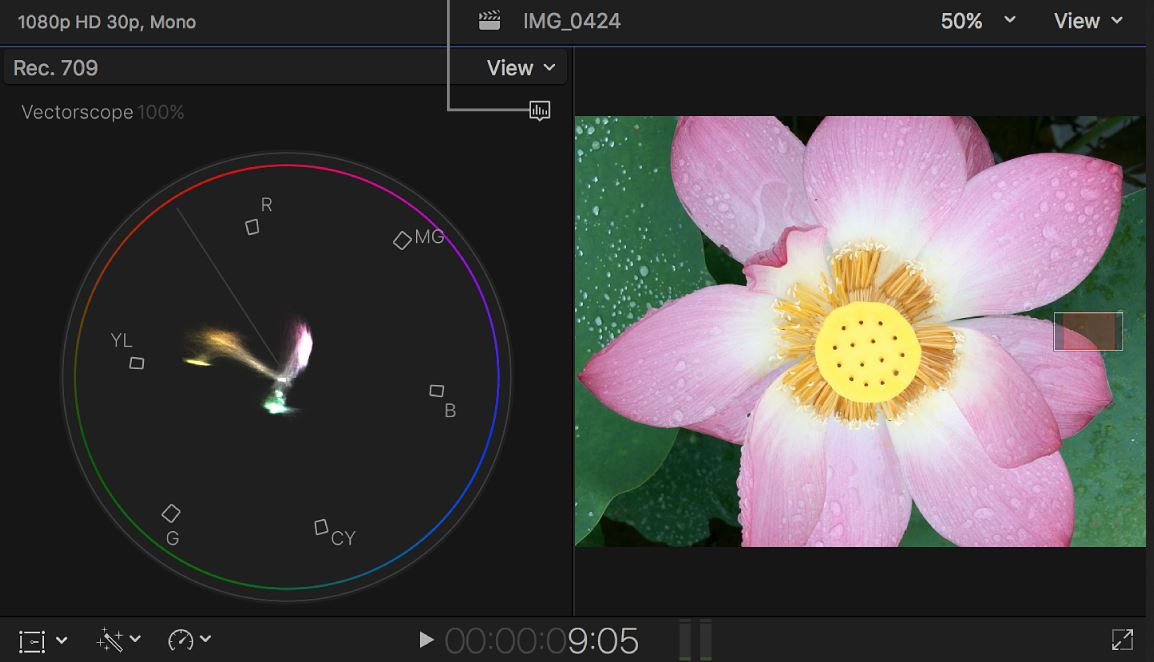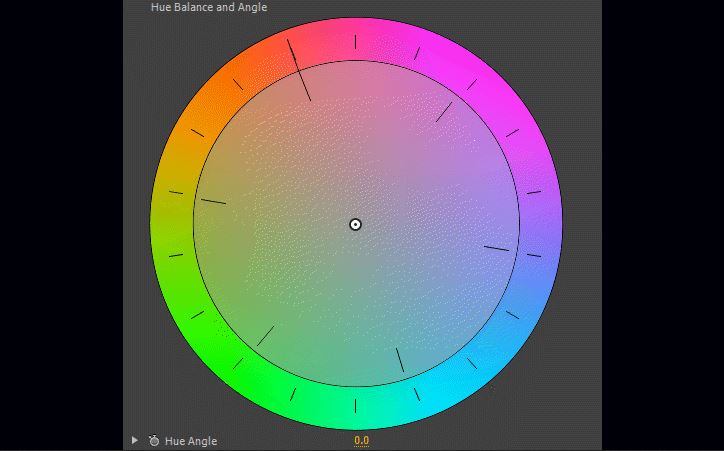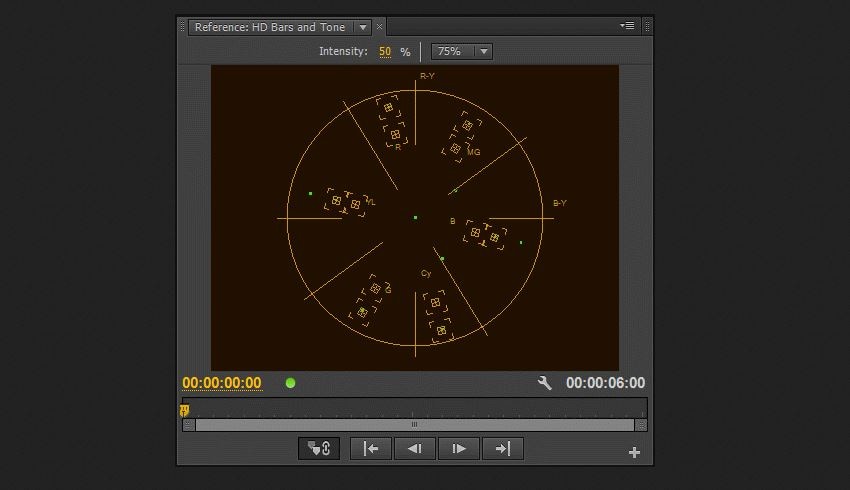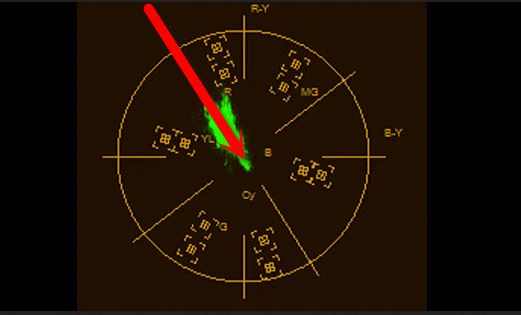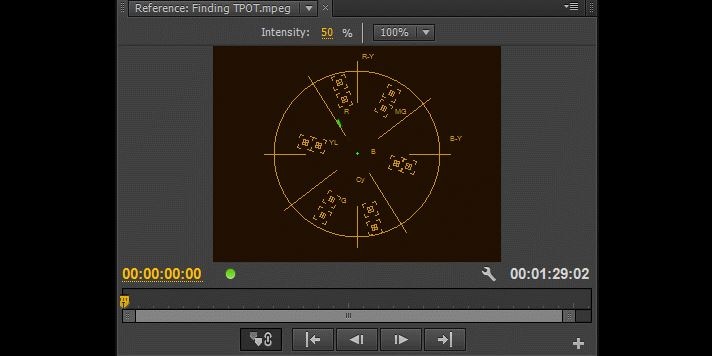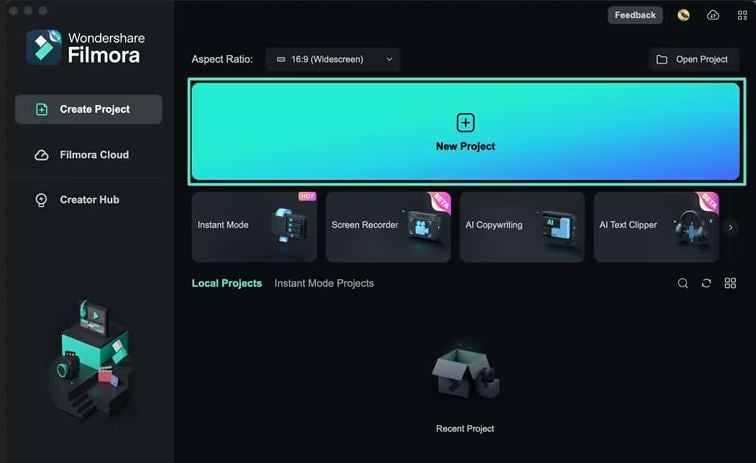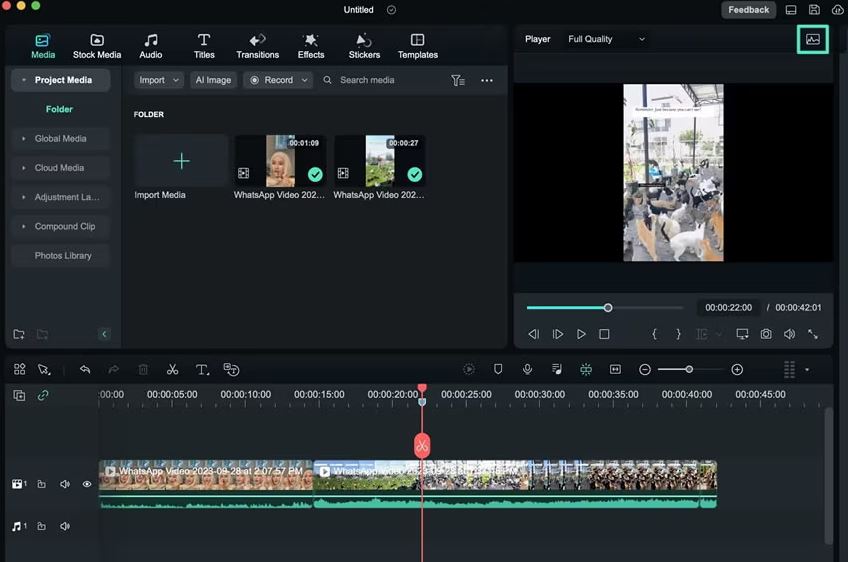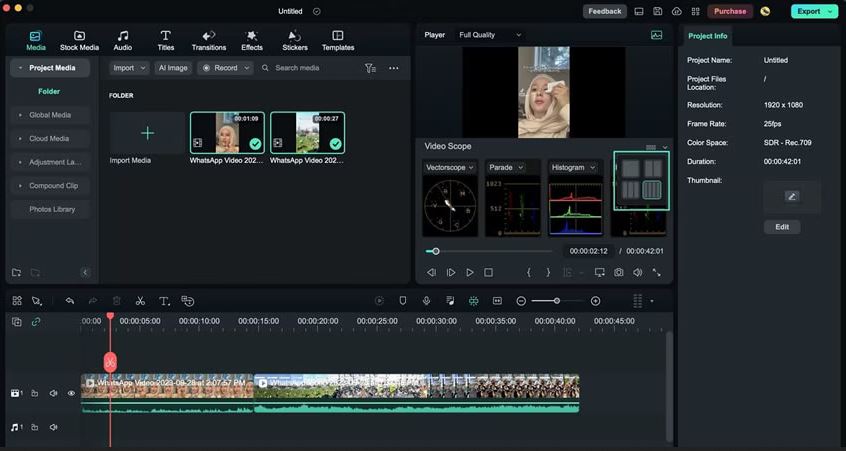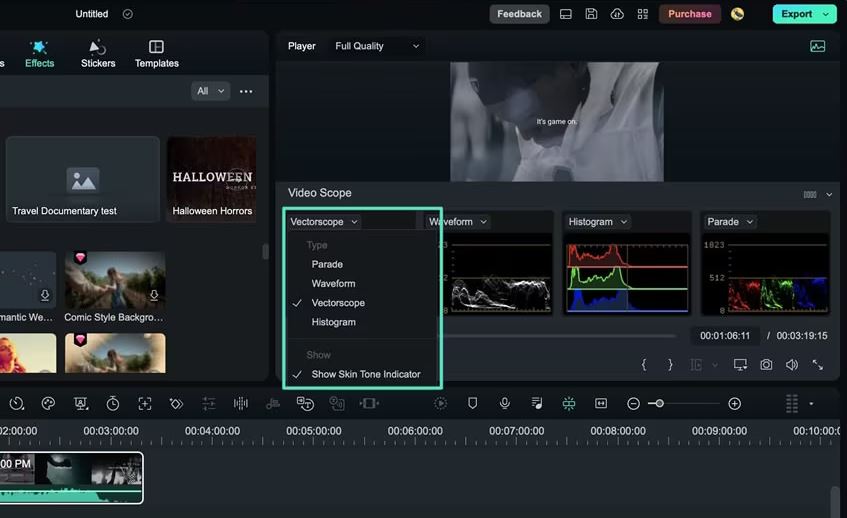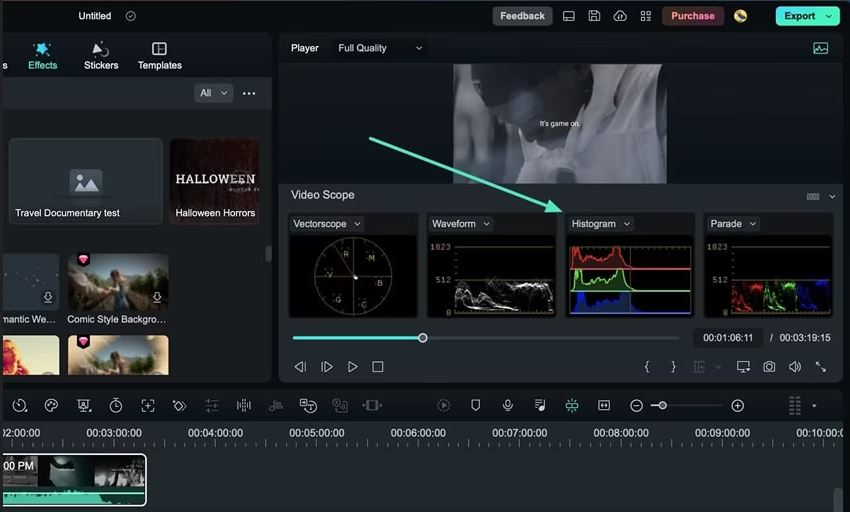
New In 2024, How to Create the Night-to-Day Effect Video

How to Create the Night-to-Day Effect Video
Do you wish you could control when it’s nighttime to daytime? It would make getting ready in the morning much faster! This tutorial will show you how to use the keyframe and mask feature in Filmora to make a remarkable night-to-day transition.
How-to Guide
1) Preparation
For this effect, you will need to shoot two footage shots with the same frame. The first is for the daytime clip, and the second is for nighttime.
But before that, you need to prepare some things, such as:
- Tripod to ensure your camera stays at the same point, so the frame doesn’t change.
- Mark the place where you want to shoot the scene. You can put a marker on the floor to ensure that you perform at the same spot in different shots.
Once done, let’s start shooting to get the footage.
2) Steps
Shooting footages
First, get the daytime shot. For this tutorial, we will pretend that you are walking and transitioning into nighttime at the spot you have marked.

Now, let’s film the nighttime clip. You will walk through the living room and do the same movement again at the same spot. You can dim the light and change the camera’s white balance settings to bluer to create a night feeling.

After you have both clips that you need, let’s go to Filmora and start editing.
Night-to-day transition
Step1 Launch Filmora and import the footage into the program. If you haven’t installed it, you can download Filmora on their website here: https://filmora.wondershare.com
Step2 Place the nighttime video clip on the first video track of the timeline and place the daytime clip on the top.

Step3 Find the spot where you want to create a transition between the day and nighttime. Then, you can delete the unwanted part.

Step4 Since the transition for this tutorial is where the subject started waving, make sure to place the daytime clip at the same time the subject started waving in the nighttime clip. Hence, the timing in both clips syncs.
Masking transition
For the next step, we will make a masking transition with the Filmora mask feature.
Step1 Double-click the daytime clip on the timeline. In the Filmora setting, find the Mask section > Circle. You can see the mask is applied in the preview screen.

Step2 Scroll down the setting and click add a keyframe at the beginning of the clip.

Step3 Change the scale of the mask to the smallest number and adjust the Width and Height down to 0. You can set the blur strength to 15 to make the transition edge smoother.

Step4 Move the play head to find the spot where you want the mask fully opens up, then add another keyframe. Change the scale of the mask to 2 and the Width and Height to 50. Make sure the mask occupies the whole frame.

Now, if you play back, you can see the nighttime becomes daytime through the mask.

If the movement in the two clips is a bit off, you can fix it by adding more keyframes on the mask.
3) Pro tips
You can add one more effect in Filmora to make it more magical. To do this, open the Effects window on the top left and find “Heartbeat” under the Basic section.

Drag and drop it onto the third video track and start the effect when the mask opens up. Then, trim the effect length to match the movement. Adjust the speed of this effect if needed.

The final result will look like this:

Summary
That is how to do this night-to-day transition night-to-day time shift effect in Filmora. By the end of this tutorial, you should be able to use the masking transition technique. You can apply and adjust it based on your needs.
Free Download For Win 7 or later(64-bit)
Free Download For macOS 10.14 or later
Free Download For macOS 10.14 or later
How to Add Font Effects to Videos
Adding titles and texts to a video clip during the post-production phase is a common thing. You may need to add texts in the intro and outro of the video as well as to highlight important parts in the middle of the video. Showing regular and static texts and titles is very unappealing, and that is why everyone includes font effects to animate the texts.
There are different types of font effects available to apply to the texts and titles in your video. There are premium video editors available with a wide range of effects such as After Effect font effects. If you are an occasional video creator, you can use online font effects while you edit your videos on the go. We will illustrate how to add font effects to videos on any device.
Part 1. Add Font Effects to Video on Windows PC
If you have the video where you want to edit and add font effect on your Windows PC, you will need a video editor where the font effects are available. If you are a regular video creator, you should opt for a premium video editor, and we recommend Wondershare Filmora. Filmora is a professional video editor with a super intuitive user interface. You can add texts and titles and add animation to the text conveniently without any prior knowledge or experience.
Filmora has a wide range of effects and animations that you can add to the text of the video. In fact, there are categorized so that you can choose from them as per your requirements. All you have to do is go for font effect download and apply them to any text on your video. Here are the steps to add font effects to video on your Windows computer.
Step1Download and install Wondershare Filmora for Windows PC. Launch the application to edit your video.
Step2To start a new project, click on New Project option on the welcome screen. Alternatively, you can go to File> New Project from the menu bar.
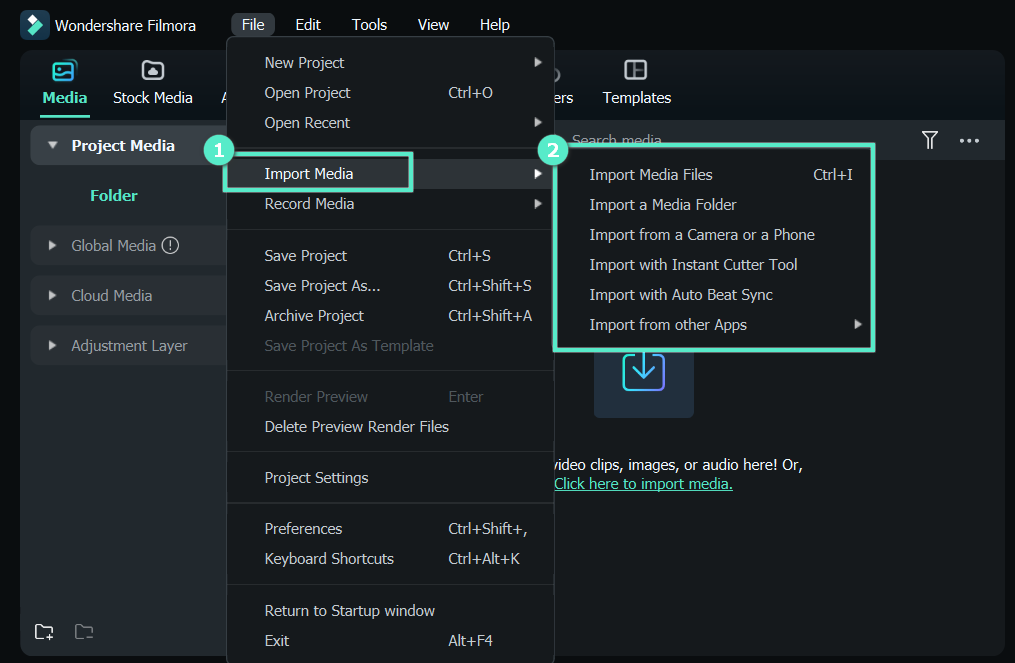
Step3Import your video file from your hard drive by going to File> Import Media> Import Media Files from the menu bar. Alternatively, you can drag and drop the video file into Project Media folder.
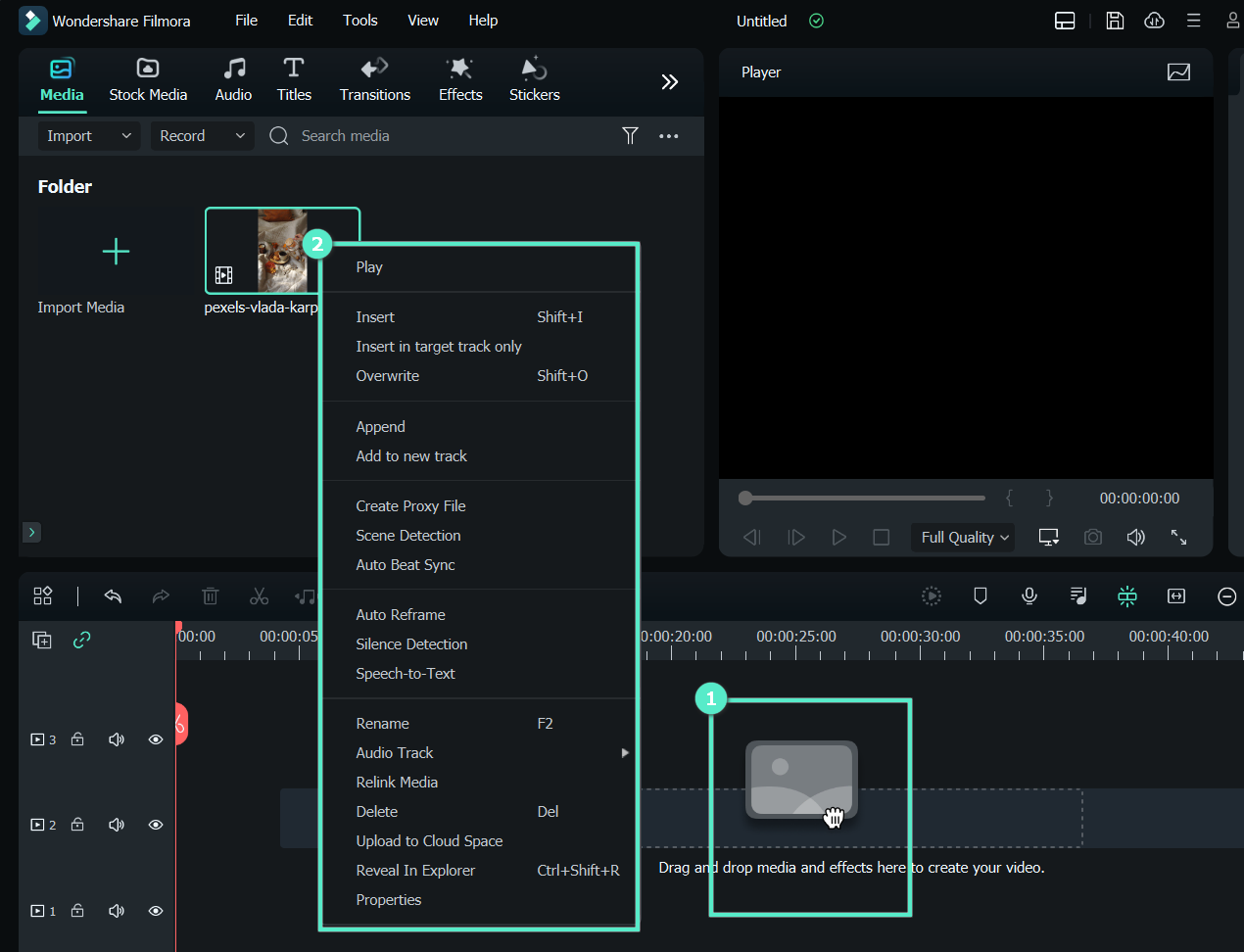
Step4Drag and drop the video file into the Timeline. You can add multiple video clips. Thereafter, you can arrange them in proper order on the Timeline.
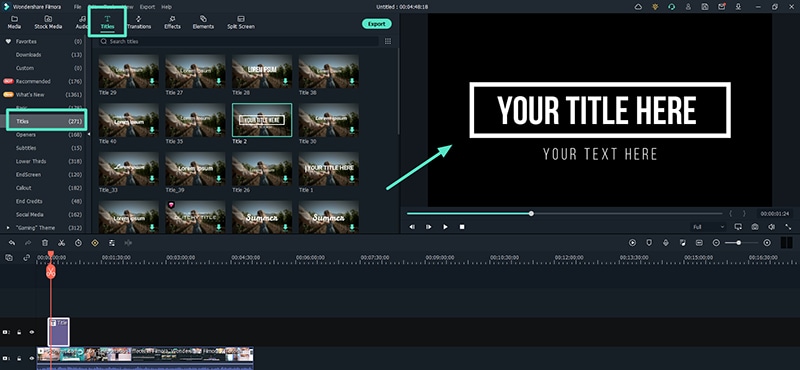
Step5Go to Titles located at the top bar. From the left panel, select any category of text effect and drop into the Timeline on top of the video clip. You should place the text effect on the Timeline wherever you want it to appear in the video. You can also stretch the duration of the text effect as per your preference.
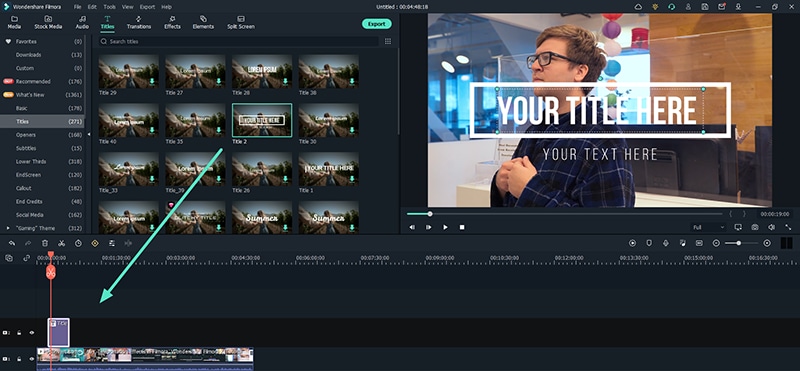
Step6Customize the text effect by double clicking on the text effect located on Timeline. Under Preset tab, you will find different font effects and styles. Change the text, font, size, color, and every other parameter as required. For more customization, you can click on Advanced button. Finally, click on OK button.
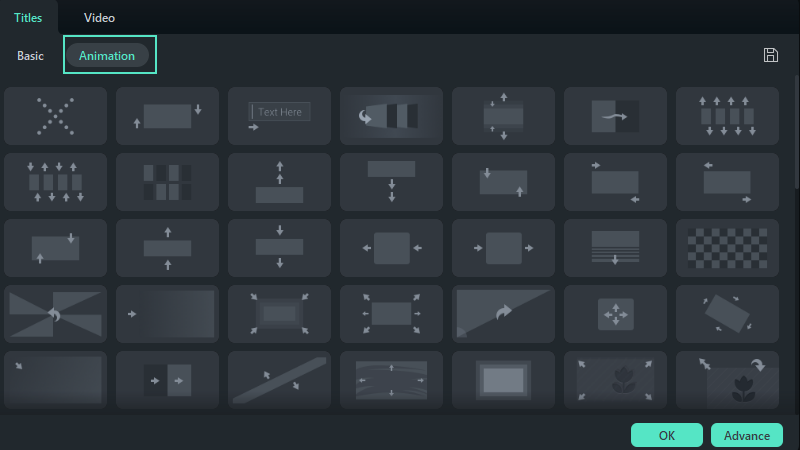
Step7Play the video and click on Export button. Select your desired file format and save the edited video on your hard drive.
Part 2. Add Video Font Effects on Mac
If you are using a Mac where you want to edit your video and add font effects, you do not have to install any external video editor. This is because Mac comes with a built-in video editor called iMovie by Apple where you can easily add font effects. There are different types of video font effects available on iMovie starting from animated titles to credits and callouts. You can get similar font for After Effect on iMovie. Here are the steps to add video font effects on Mac.
Step1Open iMovie on your Mac from Applications folder. Go to File> Import Media option to import your video under Project Media.
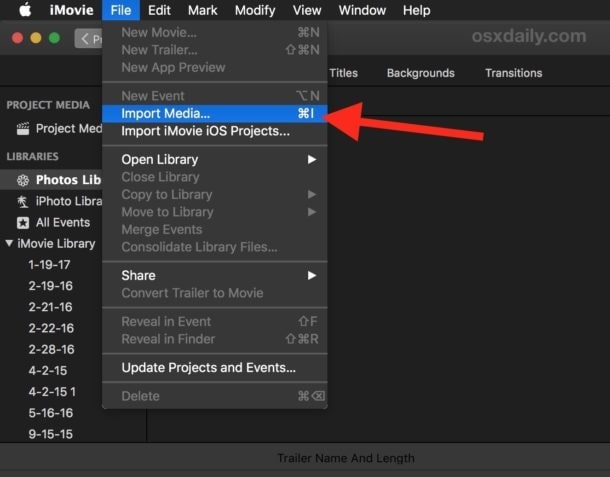
Step2Drag and drop the selected video into Timeline for your iMovie project. Click on Titles tab located at the top.

Step3Place the mouse point over the different text styles to check them. Drag and drop the desired text style into the Timeline and place it where you want the text to appear. You can stretch the duration of the text effect.

Step4From Viewer interface, double click on the text part of the video to customize the text. You will see options to change the font, font size, color and much more.

Step5Play the video and once you are satisfied, go to File> Share> File and save the edited video on your storage device.
Part 3. How to Add Font Effects Online
If you edit videos occasionally and you want to add font effects to your video without downloading any video editor, you can use an online video editor. There are several online video editors you will come across, but for adding free font effects, we recommend FlexClip video editor. It is a completely free online video editor where you can edit and export video without any watermark. There are several elegant font effects available, and you can make easy adjustments instantly. Here are the steps to add font effects to your video.
Step1Open your web browser and visit on “flexclip.com/tools/add-text-to-video”. Click on Browser Video button. Select the video from your storage device.

Step2Once the video is uploaded, you will see Text tab already selected. Go through the list of font effects available. Drag and drop the desired font effect into the video on the Viewer.

Step3Double-click on the font effect on the Viewer and customize all the parameters such as text, size, and style.

Step4Once you are satisfied, click on Export button in the top-right corner.

Conclusion
Adding font effects on video is a common practice especially when you have intro and outro in your video clip. Instead of the regular titles and texts, you should opt for creative font effects so that the text parts on your video look attractive. If it is a one-time thing, you can opt for an online video editor. If you use a Mac, you can use iMovie, and for Windows PC, we recommend Wondershare Filmora .
Free Download For Win 7 or later(64-bit)
Free Download For macOS 10.14 or later
Free Download For macOS 10.14 or later
Demystifying the Vectorscope: A Comprehensive Guide for Premiere Pro Color Correction
Our eyes process colors differently. When two people look at the same picture, they may see different shades of colors. In post-production, Vectorscopes help to color grade and make sure you get your images exactly right. This means that you will process the exact color that you want across devices. Premiere Vectorscope is a great choice for anyone looking to correct and grade colors. Using Vectorscope Premiere allows you to get quantitative data about your image for a more accurate assessment of colors within the film. In this article, we explore what comprises Premiere Pro Vectorscope and how to use them in video editing.
Color Correction Editor An easy-to-use video editor helps you make color correction and color grading experience for videos!
Free Download Use Vectorscope in Filmora Try Color Correction

Part 1. Vectorscope: What is It and How to Read
Vectorscopes provide a great post-production way for color correction. It is video scope that provides greater data about the color properties of an image. Another way to look at it is that a Vectorscope is a circular graph, which monitors the following information of an image. By looking at it, you can measure saturation outward from the center while hue is measured in a circular pattern.
The Vectorscope contains markings indicating the degree of saturation and hue in an image. The distance of the markings from the center indicates how saturated the color is in your image. In simple terms, the further the markings, the more saturated the color. The two main options of Vectorscope are HLS and YUV. The HLS displays the hue, lightness, saturation, and signal information at a glance. On the other hand, the YUV mode contains several color boxes, giving accurate levels of hue and saturation.
Vectorscopes are useful to filmmakers and editors to ensure greater conformity in a film as they transition from one shot to the next. When the camera captures an image with too much saturation, using a Vectorscope helps to reduce the said saturation. This makes Vectorscope a useful feature for color correction and color grading. Color correction involves altering the colors of an image within a film to provide consistency and tone for the film. On the other hand, color grading is more like a supercharged version of color correction. It refers to altering a film so that it matches a tone or theme. Since the two, grading and correction are important, more video editing will use a combination of both.
How to Read a Vectorscope
Learning how to read a Vectorscope will make your video editing fun and easier. The best way is to view the Vectorscope in relation to the color wheel. When using Premiere Vectorscope, the colors are nicely labeled for anyone to understand. You only need to understand the primary colors of saturation and hue to accurately read a Vectorscope.
The hue color is the direction to which the marketer points. For instance, a marker pointing toward the boxes labeled “R” indicates that the hue is predominantly red. On the other hand, the saturation correlates to the length of the marker. The image is more saturated when the marker is furthest from the center of the wheel.
Keep note of the two boxes in each main color. The box that is close to the center indicates 75%, and you will normally avoid the marker extending beyond this first box. Any marketer that extends beyond this is known as non-broadcast safe or illegal colors. Although you may need to go beyond the first box in some projects for stylistic reasons, the general rule of thumb is to avoid that.
Without proper calibration, your images may end up looking too red or too blue. They will not look natural at all and will affect the overall quality of your video. Therefore, using the features within the vectorsope will help you color-grade your images to perfection.
Part 2. Vectorscope in Premiere Pro : A Brief Guide
Just like many other video editing software, Adobe Premiere Pro offers Vectorscope to help in post-production. The best way to look at Vectorscope in Premiere Pro is to use the Color Correction workspace. Once you have launched the software, Click Window, followed by Workspace, and then Color Correction. Access the reference monitor directly to deliver the program.
The reference monitor will first display composite video. Clicking on the setting icon allows you to access the panel and choose the video scope you want to use. Now, this is how you use the Vectorscope in Premiere Pro:
1. Reading a Vectorscope on Premiere Pro
A Vectorscope is similar to a color wheel. It displays colors in the same places as the wheel, with cyan to the bottom right and red to the top left. When you see a dot or line in the Vectorscope, you can tell it is giving you information about the color or chrominance of a shot. Essentially, this information is the hue (specific color) and the saturation (the strength of that hue).
As you examine the Vectorscope, you get to see how strong a particular color is by the length of the line from the center of the wheel. A longer line indicates that the color is more saturated. However, all Vectorscopes have small color targets. The Vectorscope points are lined with a drop-down used to read the scope. The default is set to 75%, which is a good limit for a typical broadcast system.
2. Adjusting Skin Tones
A commonly used feature of the Premier Pro Vectorscope is the Skin Tone Line. With this feature, you get the line on the scope between the Yellow and the Red sections at about 10.30 or 11 o’clock position.
The Vectorscope skin tone line represents the color of blood flowing through the skin. You can use this line to check the accuracy of skin tone color representation regardless of the ethnicity of the person you’re filming. In particular, video images are more accurate
The major problem is figuring out how to look at skin tones in a shot with many other colors. With the skin tons line in Premiere Pro, color correction becomes easy and quick. You only need to use a garbage matte, which is found under video effects then keying. Adjust the points so that they cover the skin of the person on the shot, then look at the Premiere Pro Vectorscope to see your end results.
Part 3. How to Use Vectorscope in Filmora : Step-by-Step Guide
The choice of video editing software can have an impact on how well you use your Vectorscopes. Wondershare Filmora is a great choice for anyone who wants to achieve great results with their videos. The versatile video editing software offers four types of video scopes, including the Vectorscope. This gives you more flexibility in video editing and achieving accurate results in color correction and grading. With the recent V13, you also get access to a range of AI features that make video editing quicker and easier.
Free Download For Win 7 or later(64-bit)
Free Download For macOS 10.14 or later
Access Vectorscope on Filmora
Accessing Vectorscope in Filmora is straightforward. As part of the four available video scopes, Filmora has made it easy to use Vectorscope during video editing. Here is a step-by-step guide to follow:
Step 1Create a New Project on Filmora
Once you have downloaded and installed the Filmora software on your desktop, launch it and click Create a New Project.
Step 2Access Video Scopes
After starting a new project, head to the top right corner of the main interface. Click on the Video Scope button to launch the video scope bar on the preview screen.
Step 3Customize Video Scopes Layout Bar
Customizing the layout of the video scope bar allows you to have more freedom in using the feature. You have the option to choose from four layouts or expand the button to display the video scope’s name. The purpose of this step is to modify the display option of the video scopes, allowing you to have a clear view of what you are editing.
Step 4Manage the Vectorscope as Desired
On the preview screen, choose the Vectorscope option. This video scope allows you to define the skin tone indication for better color grading and correction.
Step 5Change Other Video Scopes
To achieve more accurate and better results, explore the other video scopes in the same window. View the color changes in your image through parade, histogram, and waveform video scopes. You can also change the color channels to view specific color changes across the video.
Conclusion
Vectorscopes are great for post-production color correction. Although lesser-known features to many people, they are widely used in video production. They ensure that the colors in your video are consistent across all clips or shots of your film. Since filming will often involve different shots and settings, we recommend using Wondershare Filmora for your video editing. It comes with an easy-to-use Vectorscope and other video scopes that help you achieve great results with color correction and grading.
Free Download Use Vectorscope in Filmora Try Color Correction

Part 1. Vectorscope: What is It and How to Read
Vectorscopes provide a great post-production way for color correction. It is video scope that provides greater data about the color properties of an image. Another way to look at it is that a Vectorscope is a circular graph, which monitors the following information of an image. By looking at it, you can measure saturation outward from the center while hue is measured in a circular pattern.
The Vectorscope contains markings indicating the degree of saturation and hue in an image. The distance of the markings from the center indicates how saturated the color is in your image. In simple terms, the further the markings, the more saturated the color. The two main options of Vectorscope are HLS and YUV. The HLS displays the hue, lightness, saturation, and signal information at a glance. On the other hand, the YUV mode contains several color boxes, giving accurate levels of hue and saturation.
Vectorscopes are useful to filmmakers and editors to ensure greater conformity in a film as they transition from one shot to the next. When the camera captures an image with too much saturation, using a Vectorscope helps to reduce the said saturation. This makes Vectorscope a useful feature for color correction and color grading. Color correction involves altering the colors of an image within a film to provide consistency and tone for the film. On the other hand, color grading is more like a supercharged version of color correction. It refers to altering a film so that it matches a tone or theme. Since the two, grading and correction are important, more video editing will use a combination of both.
How to Read a Vectorscope
Learning how to read a Vectorscope will make your video editing fun and easier. The best way is to view the Vectorscope in relation to the color wheel. When using Premiere Vectorscope, the colors are nicely labeled for anyone to understand. You only need to understand the primary colors of saturation and hue to accurately read a Vectorscope.
The hue color is the direction to which the marketer points. For instance, a marker pointing toward the boxes labeled “R” indicates that the hue is predominantly red. On the other hand, the saturation correlates to the length of the marker. The image is more saturated when the marker is furthest from the center of the wheel.
Keep note of the two boxes in each main color. The box that is close to the center indicates 75%, and you will normally avoid the marker extending beyond this first box. Any marketer that extends beyond this is known as non-broadcast safe or illegal colors. Although you may need to go beyond the first box in some projects for stylistic reasons, the general rule of thumb is to avoid that.
Without proper calibration, your images may end up looking too red or too blue. They will not look natural at all and will affect the overall quality of your video. Therefore, using the features within the vectorsope will help you color-grade your images to perfection.
Part 2. Vectorscope in Premiere Pro : A Brief Guide
Just like many other video editing software, Adobe Premiere Pro offers Vectorscope to help in post-production. The best way to look at Vectorscope in Premiere Pro is to use the Color Correction workspace. Once you have launched the software, Click Window, followed by Workspace, and then Color Correction. Access the reference monitor directly to deliver the program.
The reference monitor will first display composite video. Clicking on the setting icon allows you to access the panel and choose the video scope you want to use. Now, this is how you use the Vectorscope in Premiere Pro:
1. Reading a Vectorscope on Premiere Pro
A Vectorscope is similar to a color wheel. It displays colors in the same places as the wheel, with cyan to the bottom right and red to the top left. When you see a dot or line in the Vectorscope, you can tell it is giving you information about the color or chrominance of a shot. Essentially, this information is the hue (specific color) and the saturation (the strength of that hue).
As you examine the Vectorscope, you get to see how strong a particular color is by the length of the line from the center of the wheel. A longer line indicates that the color is more saturated. However, all Vectorscopes have small color targets. The Vectorscope points are lined with a drop-down used to read the scope. The default is set to 75%, which is a good limit for a typical broadcast system.
2. Adjusting Skin Tones
A commonly used feature of the Premier Pro Vectorscope is the Skin Tone Line. With this feature, you get the line on the scope between the Yellow and the Red sections at about 10.30 or 11 o’clock position.
The Vectorscope skin tone line represents the color of blood flowing through the skin. You can use this line to check the accuracy of skin tone color representation regardless of the ethnicity of the person you’re filming. In particular, video images are more accurate
The major problem is figuring out how to look at skin tones in a shot with many other colors. With the skin tons line in Premiere Pro, color correction becomes easy and quick. You only need to use a garbage matte, which is found under video effects then keying. Adjust the points so that they cover the skin of the person on the shot, then look at the Premiere Pro Vectorscope to see your end results.
Part 3. How to Use Vectorscope in Filmora : Step-by-Step Guide
The choice of video editing software can have an impact on how well you use your Vectorscopes. Wondershare Filmora is a great choice for anyone who wants to achieve great results with their videos. The versatile video editing software offers four types of video scopes, including the Vectorscope. This gives you more flexibility in video editing and achieving accurate results in color correction and grading. With the recent V13, you also get access to a range of AI features that make video editing quicker and easier.
Free Download For Win 7 or later(64-bit)
Free Download For macOS 10.14 or later
Access Vectorscope on Filmora
Accessing Vectorscope in Filmora is straightforward. As part of the four available video scopes, Filmora has made it easy to use Vectorscope during video editing. Here is a step-by-step guide to follow:
Step 1Create a New Project on Filmora
Once you have downloaded and installed the Filmora software on your desktop, launch it and click Create a New Project.
Step 2Access Video Scopes
After starting a new project, head to the top right corner of the main interface. Click on the Video Scope button to launch the video scope bar on the preview screen.
Step 3Customize Video Scopes Layout Bar
Customizing the layout of the video scope bar allows you to have more freedom in using the feature. You have the option to choose from four layouts or expand the button to display the video scope’s name. The purpose of this step is to modify the display option of the video scopes, allowing you to have a clear view of what you are editing.
Step 4Manage the Vectorscope as Desired
On the preview screen, choose the Vectorscope option. This video scope allows you to define the skin tone indication for better color grading and correction.
Step 5Change Other Video Scopes
To achieve more accurate and better results, explore the other video scopes in the same window. View the color changes in your image through parade, histogram, and waveform video scopes. You can also change the color channels to view specific color changes across the video.
Conclusion
Vectorscopes are great for post-production color correction. Although lesser-known features to many people, they are widely used in video production. They ensure that the colors in your video are consistent across all clips or shots of your film. Since filming will often involve different shots and settings, we recommend using Wondershare Filmora for your video editing. It comes with an easy-to-use Vectorscope and other video scopes that help you achieve great results with color correction and grading.
[Top List] Best VHS Sound Effect That You Can Use in Video Making
Do you know why some videos grab your attention more than others? It’s about the visuals and the effects used in those videos. Effects are important in improving the overall experience and making a video more engaging. But it’s not just limited to video effects; audio effects can make a significant difference too. You can create specific themed content by adding effects to your videos.
When it comes to quality content, audio effects can add an extra layer of depth to it. They can transport you to a different time, place, or mood. However, you can create an old vintage-style video and make your audience go “WOW.” You can add an old retro-themed filter to your video, but adding a VHS sound effect is more important. This audio effect will make your video look more authentic and professional.
Part 1: How Are VHS Sound Effects Helpful in Video Creation?
Do you know how much VHS noise sound effects can be helpful? No problem if you don’t know how because this portion is going to answer you anyway.
1. Creates a Nostalgic Ambiance
VHS sound effects can bring back the feeling of nostalgia, just like the visual effects. The distinct sounds associated with VHS, like the gentle hum and hiss, create a vintage ambiance. It can make your video feel more authentic and take viewers back to the time of VHS tapes.
2. Adds Authenticity
Adding VHS audio effects can make your video feel more authentic. Similarly, if you want to recreate the experience of watching content on VHS tapes, this effect can help. Simulating audio imperfections like dropouts and tracking errors can make the video seem more genuine.
3. Sets Time Period
These audio effects help set the period and setting of your video. You can match the sound with the visuals using VHS tape sound effects. Moreover, it creates a consistent audio-visual experience that accurately represents a particular era.
4. Improves Genre and Atmosphere
Such sound effects are particularly effective in genres like horror or suspense. The gritty or distorted audio aesthetic associated with VHS can add depth and intensity to a video. It further improves the experience of your content and engages your audiences.
5. Experimenting Unconventional Techniques
Audio filters like VHS allow filmmakers and video creators to express their artistic style and vision. Using VHS-inspired audio elements, you can experiment with unconventional techniques. It also creates unique and original compositions that stand out from traditional sound designs.
Add VHS Sound Effect to Video
Simply add sound effects on video with Filmora Video Effect Editor ! Experience the magic of cool yet outstanding video effects, where your videos come to life in beautiful visuals.
Apply VHS Sound Effect Apply VHS Sound Effect Learn More >

Part 2: Best VHS Sound Effects To Use in 2024
A video is incomplete without good-quality audio and sound effects. So, if you want to create a VHS-style video, make sure to use VHS audio filters as well. Here are some classic VHS sounds you can use for your content.
1. Video Cass. Recorder 06
This audio effect gives your video the nostalgic feel of an old video reel playing. Its VHS-inspired audio effects last for 30 seconds. You can use this effect to create a vintage atmosphere in your videos. This effect can also transport your viewers back to the era of classic video recordings.
2. Creepy Distortion
You can create a haunting and unsettling atmosphere with this sound effect. It adds a creepy VHS sound distortion effect to your content. This effect is perfect for horror or suspenseful scenes. Moreover, this audio filter has a duration of 30 seconds.
3. VCR Deck Insert VHS Ta PE416803
With this audio effect, you can simulate the experience of inserting a tape into a VCR. You can add this effect to your video to enhance the authenticity and realism of a scene. It will help you in a situation where a tape is being loaded into a VCR. The duration of this audio is 20 seconds.
4. VCR Deck Insert VHS Ta PE416801
In this effect, you can hear the sound of someone inserting a tape into a VCR and pressing the play button. You can use this effect when showing scenes of tapes being loaded and played on a VCR. This 10-second audio effect will add an extra layer of realism and nostalgia.
5. VHS Player
Experience the entire process of using a VHS tape with this audio effect. You’ll hear the opening of the VHS box, inserting it into the VCR, followed by the playback sound. Then, there’s the fast-forward effect; additionally, you can enjoy the sound of the fast reverse. Finally, you’ll hear the stop, ejection of the VHS, and the storage of it back into its original box. This effect lasts for 3 minutes and 5 seconds.
6. VCR: Forward
Get the feeling of fast-forwarding through a VHS tape with this sound effect. It lasts 1 minute and 4 seconds and adds the authentic sound of a fast-forwarding VHS tape. You can use this audio effect when you want to add a similar effect to your content.
7. VCR VHS Tape Rewind M PE1046902
You can use this effect in your VHS-styled videos. It produces the sound of a VHS tape rewinding, followed by the VHS pause sound effect. This effect adds a distinct audio cue for rewinding and pausing scenes involving a VHS. The duration of this VHS effect is 4 seconds.
8. VCR: Rewind
Take a trip back in time with the sound of a VHS tape being rewound. This audio file adds a VHS rewind sound effect to your video. The duration of this file is 1 minute and 9 seconds. It will provide the nostalgic sound of a quick rewinding of a VHS tape.
9. Video Cass. Recorder 07
Using this audio effect, you can create the sensation of a video reel playing in a video cassette recorder. This VHS audio filter lasts for 30 seconds. You can use this effect to emphasize the vintage vibe of your video further. It also adds an old-fashioned charm to your video content.
10. VHS Player Rewind
This sound effect, provided by Pixabay, lasts 1 minute and 13 seconds. It starts with a glitchy and nostalgic VHS rewind sound to your video. The audio file brings back memories of vintage technology by adding the VHS rewind effect. You can recreate the experience of the 90s using this audio filter.
Bonus Part: Creating The Best VHS-Themed Videos With Wondershare Filmora
Filmora Video Editor is the ultimate tool and an incredible software for video editing. From audio effects to professional video edits, this tool can do a lot of stuff. This tool is now powered with AI technology which means more features are added in its latest version. You can edit your video and add sound effects that sync with your content feel.
Add VHS Sound Effect For Win 7 or later(64-bit)
Add VHS Sound Effect For macOS 10.14 or later
To make such videos having VHS effects, first, you need to learn how to use Wondershare Filmora. If you follow the following steps, you can easily edit your videos.
Step 1Starting Your Project
Open Wondershare Filmora and click on “New Project” to begin. This will bring up a new window where you can get started on your video. Import your video file by selecting the “Import Media” option and choosing the file from your system. Then, drag and drop the video into the timeline area to organize and prepare it for editing.
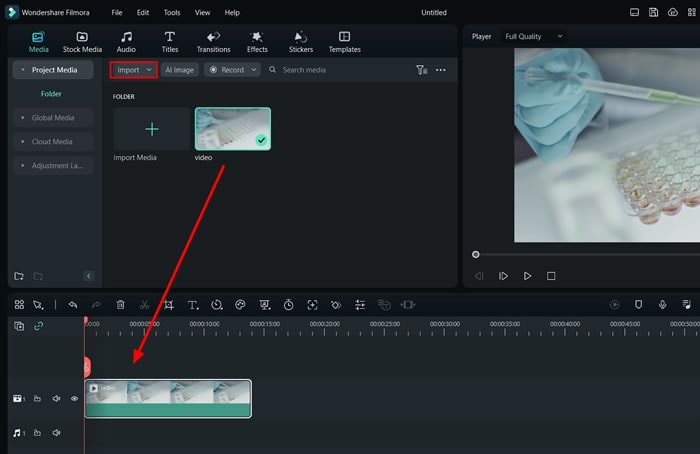
Step 2Apply VHS Effect to the Video
It’s time to add the VHS effects to your video. Look for the “Effects” option in the top bar and click on it. Next, search for “VHS” to find a variety of VHS overlays. Choose the one that suits your style and drag it onto the timeline, placing it over your video.
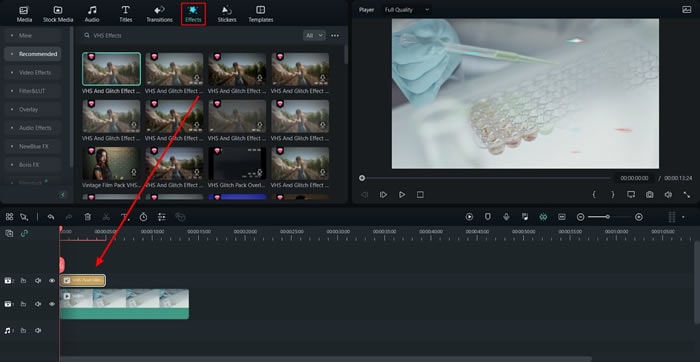
Step 3Apply VHS Sound Effects
For the VHS audio filter, go to the “Audio” tab, select “Sound Effect,” and search for “VHS.” Proceed further by selecting a suitable sound effect and dragging it onto the timeline beneath your video.
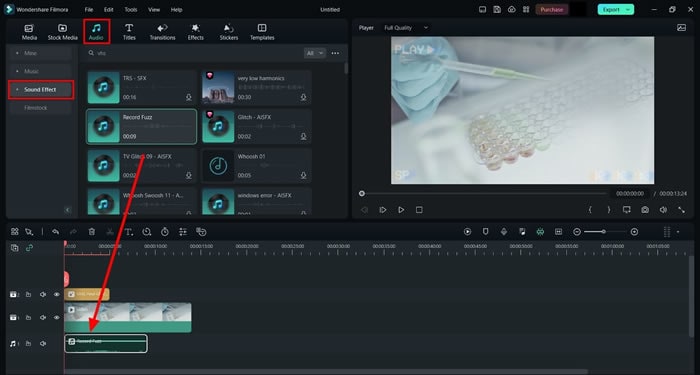
Step 4Export Your File
Once satisfied with the result, click the “Export” tab at the top left of the screen to save your video with the applied VHS effects.
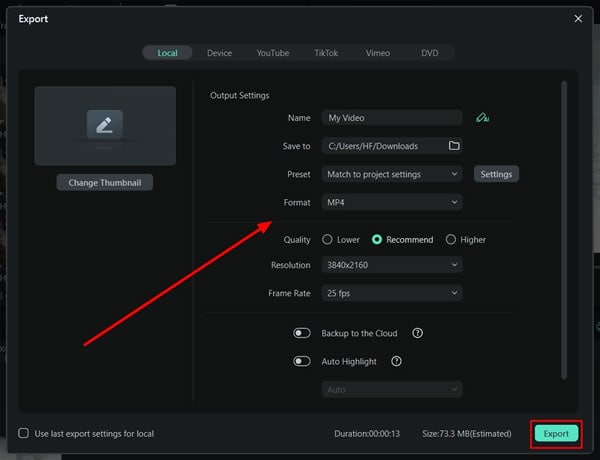
Conclusion
In conclusion, a good video depends not only on your camera. There is so much post-production work behind good-quality content. You have to create a feel and ambiance in a video using effects and other overlays. You can create an old-themed video using the right filter and adding a VHS audio effect. Wondershare Filmora provides you with a platform where you can create such content with ease.
Apply VHS Sound Effect Apply VHS Sound Effect Learn More >

Part 2: Best VHS Sound Effects To Use in 2024
A video is incomplete without good-quality audio and sound effects. So, if you want to create a VHS-style video, make sure to use VHS audio filters as well. Here are some classic VHS sounds you can use for your content.
1. Video Cass. Recorder 06
This audio effect gives your video the nostalgic feel of an old video reel playing. Its VHS-inspired audio effects last for 30 seconds. You can use this effect to create a vintage atmosphere in your videos. This effect can also transport your viewers back to the era of classic video recordings.
2. Creepy Distortion
You can create a haunting and unsettling atmosphere with this sound effect. It adds a creepy VHS sound distortion effect to your content. This effect is perfect for horror or suspenseful scenes. Moreover, this audio filter has a duration of 30 seconds.
3. VCR Deck Insert VHS Ta PE416803
With this audio effect, you can simulate the experience of inserting a tape into a VCR. You can add this effect to your video to enhance the authenticity and realism of a scene. It will help you in a situation where a tape is being loaded into a VCR. The duration of this audio is 20 seconds.
4. VCR Deck Insert VHS Ta PE416801
In this effect, you can hear the sound of someone inserting a tape into a VCR and pressing the play button. You can use this effect when showing scenes of tapes being loaded and played on a VCR. This 10-second audio effect will add an extra layer of realism and nostalgia.
5. VHS Player
Experience the entire process of using a VHS tape with this audio effect. You’ll hear the opening of the VHS box, inserting it into the VCR, followed by the playback sound. Then, there’s the fast-forward effect; additionally, you can enjoy the sound of the fast reverse. Finally, you’ll hear the stop, ejection of the VHS, and the storage of it back into its original box. This effect lasts for 3 minutes and 5 seconds.
6. VCR: Forward
Get the feeling of fast-forwarding through a VHS tape with this sound effect. It lasts 1 minute and 4 seconds and adds the authentic sound of a fast-forwarding VHS tape. You can use this audio effect when you want to add a similar effect to your content.
7. VCR VHS Tape Rewind M PE1046902
You can use this effect in your VHS-styled videos. It produces the sound of a VHS tape rewinding, followed by the VHS pause sound effect. This effect adds a distinct audio cue for rewinding and pausing scenes involving a VHS. The duration of this VHS effect is 4 seconds.
8. VCR: Rewind
Take a trip back in time with the sound of a VHS tape being rewound. This audio file adds a VHS rewind sound effect to your video. The duration of this file is 1 minute and 9 seconds. It will provide the nostalgic sound of a quick rewinding of a VHS tape.
9. Video Cass. Recorder 07
Using this audio effect, you can create the sensation of a video reel playing in a video cassette recorder. This VHS audio filter lasts for 30 seconds. You can use this effect to emphasize the vintage vibe of your video further. It also adds an old-fashioned charm to your video content.
10. VHS Player Rewind
This sound effect, provided by Pixabay, lasts 1 minute and 13 seconds. It starts with a glitchy and nostalgic VHS rewind sound to your video. The audio file brings back memories of vintage technology by adding the VHS rewind effect. You can recreate the experience of the 90s using this audio filter.
Bonus Part: Creating The Best VHS-Themed Videos With Wondershare Filmora
Filmora Video Editor is the ultimate tool and an incredible software for video editing. From audio effects to professional video edits, this tool can do a lot of stuff. This tool is now powered with AI technology which means more features are added in its latest version. You can edit your video and add sound effects that sync with your content feel.
Add VHS Sound Effect For Win 7 or later(64-bit)
Add VHS Sound Effect For macOS 10.14 or later
To make such videos having VHS effects, first, you need to learn how to use Wondershare Filmora. If you follow the following steps, you can easily edit your videos.
Step 1Starting Your Project
Open Wondershare Filmora and click on “New Project” to begin. This will bring up a new window where you can get started on your video. Import your video file by selecting the “Import Media” option and choosing the file from your system. Then, drag and drop the video into the timeline area to organize and prepare it for editing.

Step 2Apply VHS Effect to the Video
It’s time to add the VHS effects to your video. Look for the “Effects” option in the top bar and click on it. Next, search for “VHS” to find a variety of VHS overlays. Choose the one that suits your style and drag it onto the timeline, placing it over your video.

Step 3Apply VHS Sound Effects
For the VHS audio filter, go to the “Audio” tab, select “Sound Effect,” and search for “VHS.” Proceed further by selecting a suitable sound effect and dragging it onto the timeline beneath your video.

Step 4Export Your File
Once satisfied with the result, click the “Export” tab at the top left of the screen to save your video with the applied VHS effects.

Conclusion
In conclusion, a good video depends not only on your camera. There is so much post-production work behind good-quality content. You have to create a feel and ambiance in a video using effects and other overlays. You can create an old-themed video using the right filter and adding a VHS audio effect. Wondershare Filmora provides you with a platform where you can create such content with ease.
Also read:
- [New] Outstanding 10 Screenshot and Recording Titles for Gamers for 2024
- [Updated] In 2024, DuRecorder Uncovered Features and Analysis
- 2024 Approved How to Make Glitch Effect with Filmora
- 2024 Approved Identifying Trends Analyzing the Success of Your IGTV Video
- Dissecting the iSpring Screencap Magic
- In 2024, 2023'S FB URL Vault Securely Access 8 Free Downloads Online
- In 2024, Do You Know How to Create a Lol Montage Video? Had You Ever Tried that Video Type Before? Connect with This Article to Study the Tips and Tricks Associated with the Making of Montage Videos
- Mastering the Art of Twilight Portraits for 2024
- New 2024 Approved Guide Adding Audio in Wondershare Filmora
- New Create a Movie with Windows Movie Maker
- New How to Add the Popular Video Text Effects to Your Video, In 2024
- The Ultimate Hairdo Handbook Cutting-Edge Techniques
- Title: New In 2024, How to Create the Night-to-Day Effect Video
- Author: Chloe
- Created at : 2025-02-26 02:13:09
- Updated at : 2025-03-03 22:42:38
- Link: https://ai-editing-video.techidaily.com/new-in-2024-how-to-create-the-night-to-day-effect-video/
- License: This work is licensed under CC BY-NC-SA 4.0.
